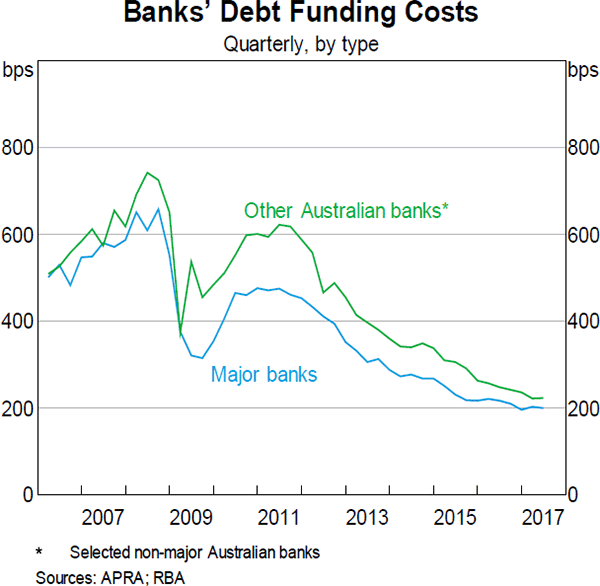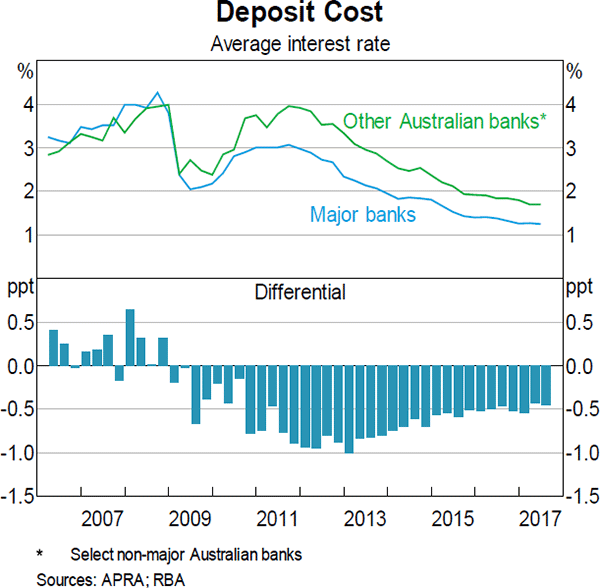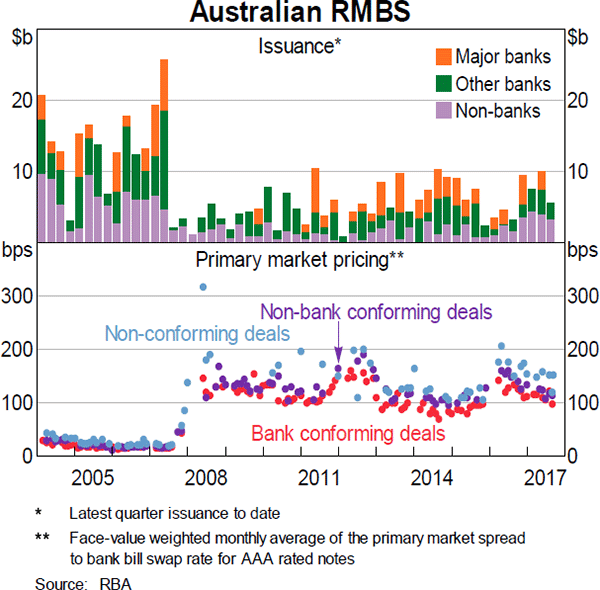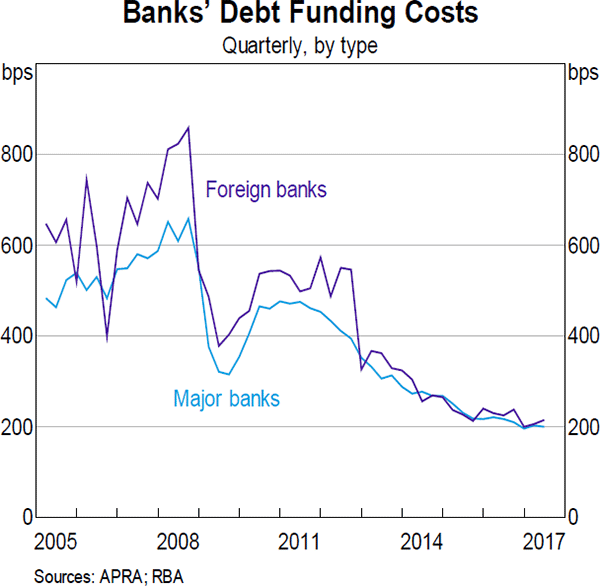Submission to the Productivity Commission Inquiry into Competition in the Financial System 4. Recent Influences on the Competitive Environment
- Download 970KB
The potential sources of competition for the major banks include smaller ADIs, foreign banks and new entrants from outside the banking sector. However, the competitive pressure imposed by these sources has varied over time. This section considers three factors that have recently influenced the level of competition: the funding cost differences between large and small ADIs; the significant contraction of the residential mortgage-backed securities (RMBS) market (which had supported lending by both smaller ADIs and mortgage originators prior to the crisis); and competition from foreign banks, which has been influential in some markets.
Funding costs
The extent of competition between financial institutions is heavily influenced by conditions in funding markets – both through the effect on lending markets and the effect on banks' relative funding costs. As funding conditions become more constrained or costly, competition in lending markets typically eases. This was seen during the global financial crisis when access to short- and long-term wholesale funding markets was highly restricted.
In addition, smaller banks' funding costs rose relative to the major banks through the crisis, reflecting different funding mixes and perceptions of risk (Graph 16). This has affected smaller banks' profitability and capacity to compete.[9] Over recent years, the differential between the major banks' and smaller banks' funding costs, including deposit costs, has narrowed (Graph 17).


Precisely attributing the difference in funding costs between the major banks and other Australian banks to any particular factor is not straightforward. It partly reflects factors such as economies of scale, diversification of business models and whether infrastructure and brand reputation are well-established. For instance, smaller banks typically have less diversified funding sources than the major banks (RBA 2014b).
Part of the difference in funding costs may reflect the value of an implicit subsidy from the Australian Government to the major banks, resulting from the perception that the major banks are ‘too big to fail’. The Government's Major Bank Levy, the Financial Claims Scheme (FCS) and a reduction in the benefits of using internal ratings-based credit risk modelling have increased the major banks' funding costs relative to other ADIs.
Residential mortgage-backed securities
In the decade leading up to the financial crisis, securitisation became an important source of funding for the mortgage market (Graph 18). It was used by a new class of mortgage lenders, known as mortgage originators, as well as smaller ADIs. These types of entities were not able to access unsecured funding markets on comparable terms to the major banks and could not raise deposits. They therefore developed a low-cost business model using securitisation funding and mobile lenders, which enabled them to undercut banks' mortgage rates (RBA 2014b).
As a result of the US sub-prime crisis, there was a reappraisal of the risks of investing in securitised products globally, and this also affected Australian markets. Access to securitisation funding was curtailed and the cost of securitisation funding rose relative to other forms of funding. While the Australian government provided some support for the RMBS market to ensure that it continued to function, issuance volumes were significantly reduced. Unlike ADIs, which have more diversified funding models and could switch into deposit funding, mortgage originators were left with limited funding volumes and were no longer able to compete on price.

Use of the RMBS market as a source of funding has increased recently, mostly due to issuance by smaller ADIs and non-ADIs, which have gained market share in the mortgage market. The increased use of RMBS is likely to be partly a reflection of accommodative financial conditions, which have resulted in stronger demand for, and a declining cost of issuing, RMBS. However, RMBS costs remain higher than before the financial crisis and relative to other forms of funding. Growth in the market appears to be constrained by limited demand from both domestic investors and non-residents, many of which prefer covered bonds (RBA 2014b; Aylmer 2016). Recent regulatory changes, which will take effect in 2018, have been designed to help improve the functioning and resilience of the securitisation market (APRA 2016).
Foreign banks
Foreign banks have played a role in shaping the competitive landscape in Australian banking markets since they were first allowed to enter in the mid 1980s. At the time, foreign banks were seen as a catalyst for competition for business and retail lending, although their entry had little initial effect on the latter (Fraser 1994). In the 1990s, the entry of foreign banks into the online deposit market saw a rise in competition, with deposit rates increasing relative to the cash rate. In the lead-up to the financial crisis, foreign banks expanded their market share in the commercial property sector as lending to this sector grew rapidly (RBA 2014b). More recently, foreign banks from Asia have competed strongly in some segments of the business lending markets.
There have been few changes in foreign bank access or ownership rules in recent decades (RBA 2014b). Instead, participation of foreign banks in Australian markets has been heavily influenced by conditions faced by their parent entities and in their home economies. Prior to the financial crisis, European and US bank participation in Australian banking markets had increased rapidly as their home economies experienced strong growth. However, as a result of the crises in these regions, these institutions quickly reduced their Australian exposures.
More recently, as Asian economies have grown strongly, Asian banks have expanded overseas, including into Australia. As in previous cycles, some foreign banks have access to low-cost funding through their parent entity and are looking to expand their operations, while others appear to be accepting a lower return on equity than Australian banks (Graph 19).

Foreign ownership limits on Australian major banks have been confirmed by successive Australian governments since the Wallis Inquiry in 1997. Furthermore, the ownership structure of the banking system is not a critical determinant of the level of competition. There are also significant hurdles to allowing substantial foreign banks to operate in retail markets (Davis 2007; RBA 2014b).
Footnote
For a discussion of how funding costs and composition have changed through time and vary across lenders, see the Reserve Bank's FSI submission (RBA 2014b) and Bulletin articles (Cheung 2017; Wilkins, Gardner and Chapman 2016). [9]